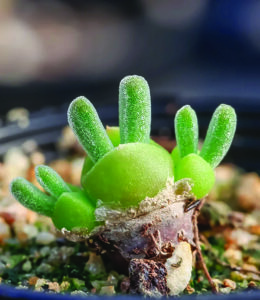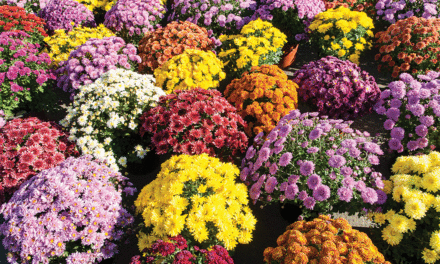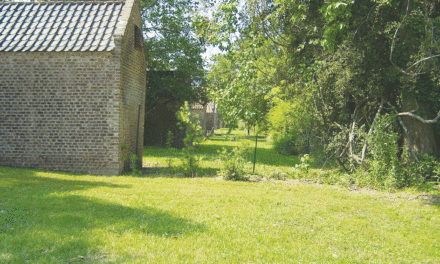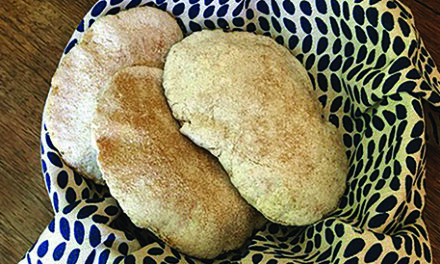
A native of South Africa, the super cute but hard-to-find bunny ear succulent has become a viral sensation. (Photo courtesy Succulents by Emma)
Flowers and bunnies mark the traditional signs of Easter everywhere. In recent years, though, a unique botanical adorably bridging flora and fauna has emerged.
Commonly called the bunny ear succulent, Monilaria moniliformis features budding green leaves bearing an uncanny resemblance, at least early on, to jade shaded bunny ears.
A native of South Africa, the super cute but hard-to-find specimen has become a viral sensation among a growing number of fans scouring its largely internet-based habitat for seeds and plants.
Hopping among local plant purveyors to learn more produced no results. The University of Maryland Extension service confirmed that efforts to locate a bunny ear succulent nearby would likely lead to a dead-end rabbit hole.
However, Etsy.com’s online emporium of enterprising crafters is also a haven for entrepreneurs dealing in hard-to-find plants, including the reclusive but increasingly sought-after bunny ear succulent.
One such grower is Cristine Geertseema, who works full-time as an analyst and began operating her Etsy enterprise, LittleKaroo, during spare nights and weekends from a spare 8-foot by 7-foot bedroom in her mint green trailer home in Cottonwood, Calif.
Completely self-taught, indoor gardening has been her personal hobby for the past five years. “I’m an avid reader and researcher and seem to have a fetish with certain species (bunny ear succulents, among them) that are rather tricky to grow,” she said.
Meaning ‘little desert’ in Afrikaan, LittleKaroo is named in recognition of the spot located on South Africa’s Western Cape, one of the few places where mesembs (mesembryanthemums), also known as “mimicry plants” grow wild. In addition to ostrich farming, the area is renowned for fantastical plants, Geertseema said. (One of her other favorite mesembs, Lithops, known as “living stone” also belongs to the Aizoaceae family.)
Geertseema described her shop as an “organic” outgrowth stemming in part from her own rocky path to growing bunny ear succulents.
“I fell in love with, and wanted to grow this species myself, but I had a very difficult time finding quality seeds and instructions,” she recalled.
Her first seeds purchased from China turned out to be counterfeit. She initially had trouble finding much written about the plants, either in print or online, something still true today, Gertseema noted. But instead of being discouraged, she became more determined than ever.
“I collected what information I could, and then spent 6 months experimenting until I developed my own handmade soil and instructions. It took me a few tries, but I also found reputable growers in Germany and South Africa, who source my seeds,” she said.
As part of her mission to help others grow bunny ear succulents and other mesembs, Geertseema offers fully stocked kits including step-by-step instructions and her custom soil blend along with growing pot and seeds.
“In my experiments, I found that a purely mineral-based substrate (a mix of granite, pumice, and calcined clay) outperformed all other traditional black soil mixes. I believe this is because the substrate more closely resembles this species’ native soil, offering optimal drainage, reduced water retention, and faster dry time, preventing root rot and fungi or bacteria growth,” she said.
The minerals are ground, hand-washed, sifted, and sterilized prior to bagging, and it can be reused continually, she added.
Another online grower, Emma Du of San Jose, Calif., set up her Etsy Shop, Succulents by Emma, last October. Originally from China, home to a very large market of succulents, Emma said she would often receive pictures of the plants her friends were growing. Inspired to try cultivating some of those over here, she applied for and received a Department of Agriculture license allowing her to import plants, first from China and later Korea.
As seeds can take a while to grow, Du said she starts propagation directly from cuttings.
“Their original environment is the desert, so they love the soil that can drain itself. For the soil I usually use 30 percent peat moss and 70 or 80 percent particles, sand or crushed up stones, to help the water drain,” she advised. “And you don’t want to over water, which will cause roots to rot. They love a place that is ventilated well, either outside where the air and wind circulate or indoors with a little fan next to them to help simulate ventilation. To grow big and healthy, sunlight is very important.” But, she added, because she likes “small, cute plants” she usually avoids adding plant food.
“When I started to import my bunny ear succulents from Korea, they were in summer hibernation, as they grow during the cooler months. Mine haven’t flowered yet as it isn’t their season right now,” she noted at February’s end.
During the pandemic lockdown, she said growing more and more succulents helped her stay positive and happy.
But after a while Emma’s expansive collection began to overtake the amount of space available to keep them.
She decided to start offering some for sale locally at first and later through her Etsy shop.
Attracted by the “very cute, pretty unique” bunny ear succulents, Emma successfully grew some for herself, then added them to her shop, never anticipating how sought after they’d become.
“I thought it was just a unique little plant, but people love them so much. At first, I sold about one or two a week, but recently it started to boom, and I sold about 300 by the end of February, almost depleting my stock,” she noted.
Seeking out others with direct experience growing bunny ear succulents, one or two popped up on Facebook groups dedicated to cacti and succulent enthusiasts, such as the Cactus and Succulent Society of Maryland and the Philadelphia Cactus and Succulent Society.
But more members expressed familiarity raising bunny ear cactus, or Opuntia microdasys, belonging to the more commonly known prickly pear cactus family.
While more readily available, one such member noted that despite the cute bunny ear shape of the tiny leaves, attempts to handle and transplant the extremely sharp prickly specimen ultimately led her to burn it and never try it again.
The World of Succulent website offers encyclopedic resource information on the bunny ear succulent, confirming it to be a winter grower that can get up to 6 inches tall, with short-lived soft leaf pairs which can also grow to 6 inches long but drop off during the summer. A single bloom, white with a yellow center, grows up to 1.6 inches in diameter.
The root of its scientific name comes from monile, meaning necklace in Latin. Other common names include string of pearls, beaded vygie, and beaded ice plant.
For more information on the bunny ear succulent, visit https://worldofsucculents.com/monilaria-moniliformis-string-pearls/






